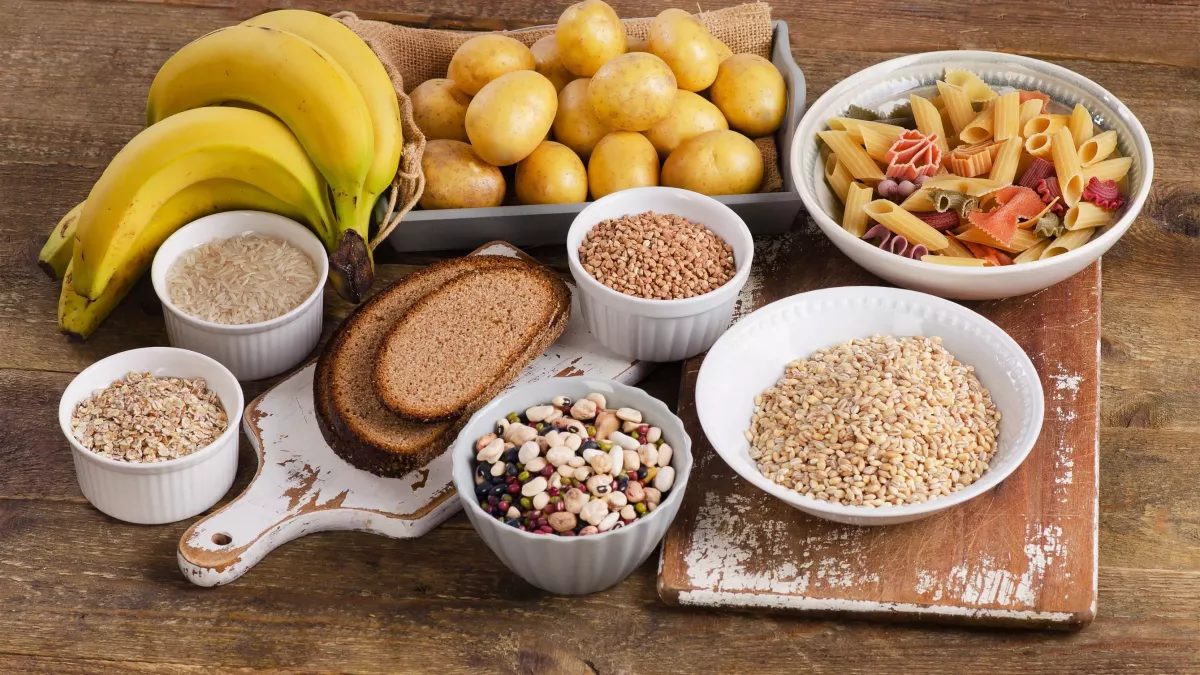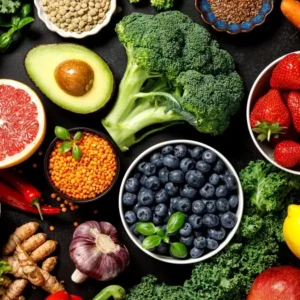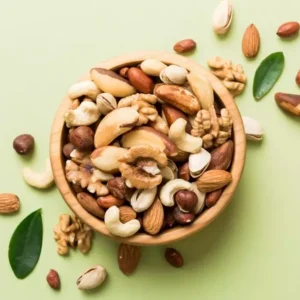Verified on 11/12/2023 by PasseportSanté
A carbohydrate is a class of organic compounds. There are two types of carbohydrates: simple carbohydrates and complex carbohydrates. Simple carbohydrates include glucose, fructose and galactose which can in turn form sucrose (=table sugar), lactose or maltose. Complex carbohydrates include starch, glycogen as well as fiber
Characteristics of carbohydrates:
- preferred energy substrates of cells;
- we distinguish between simple carbohydrates and complex carbohydrates;
- stored in the body in the form of glycogen;
- are mainly found in sweet products, starchy foods and fruits;
- Excess carbohydrates can lead to hyperinsulinism and type 2 diabetes in the long term.
Why eat foods high in carbohydrates?
Energy role
The main role of carbohydrates is to provide energy to the cells of the human body (1g of carbohydrates provides 4 calories). When we eat them, they are transformed more or less quickly into glucose, which is the fuel for certain cells in the body. This is the case for brain cells. Note that glucose is the exclusive fuel of the brain, which needs around 140 g per day.
Appetite regulation
Complex carbohydrates, and especially fiber, play an important role in regulating appetite. They allow you to reach satiety more quickly and to be satisfied longer lasting. They are therefore essential for a balanced diet.
Hyperglycémiants
All carbohydrates have their own hyperglycemic power, that of glucose being one of the highest. Simple sugars, which are more quickly assimilated, therefore make it possible to quickly raise blood sugar levels and “re-sweeten” the body. This characteristic is particularly appreciated and used by high-level athletes or even by diabetics in the event ofhypoglycemia.
Promotes good sleep
The assimilation of carbohydrates induces an increase in the availability of tryptophan in the body. Tryptophan is an amino acid precursor of, among others, serotonin and melatonin. These two substances act favorably on falling asleep.
Building glycogen stores
Glucose is either used immediately by the body, because it constantly needs energy, or stored as glycogen in the liver and muscles for later use. This is why athletes, before a competition, seek to increase their reserves of glycogen by eating foods high in carbohydrates.
What is the difference between carbohydrate and sugar?
A simple sugar is the smallest link in the carbohydrate family. It is he who is responsible for the sweet taste of food. Fructose, galactose and glucose are made up of a single molecule. When combined, they form more complex molecules. For example, sucrose (white sugar) contains fructose and glucose and lactose (milk sugar) contains galactose and glucose.
Foods high in carbohydrates
The main sources of carbohydrates are grain products, fruits, certain vegetables and legumes. In general:
- 1 serving of grain products contains: 15 g of carbohydrates;
- 1 serving of fruit contains: 15 g of carbohydrates;
- 1 serving of vegetables contains: 5 g of carbohydrates;
- 1 serving of dairy products provides: 12 to 15 g of carbohydrates;
- 1 serving of legumes provides: 15 g of carbohydrates;
- 1 serving of added sugar contains: 15 g of carbohydrates.
Here are details of the carbohydrate content of certain foods:
|
Food |
Portions |
Quantities (g) |
|
Pasta, cooked Bagel Soft drink like cola Cooked rice English muffin Corncob Mashed sweet potato Chickpeas, cooked Prepared plain oatmeal Chocolate soy drink Yoghourt with fruits Pain Crackers Quinoa, cuit Breakfast cereals Winter squash, cooked Parsnip Green peas Potato Cooked beans Cooked lentils Pineapple Cherries Clementine Dried dates Strawberries, blackberries Jus d’orange Chocolate chip cookies Jam, honey, maple syrup Skimmed milk, 1%, 2%, whole Fresh, frozen, canned vegetables Vegetable juice Leafy vegetables (lettuce, spinach) |
150 g 1 1 can (355 ml) 100 g 1 1 135 g 85 g 175 g (1 sachet) 250 ml 1 container (125 g) 1 slice (30g) 4 to 7 (20g) 75 g 30 g 215 g 115 g 170 g 1 small or 110 g puree 90 to 95 g 105 g 80 g 15 2 3 150 g 125 ml 2 15 ml 250 ml 100 g 125 ml 100 g |
45 45 35 30 30 30 30 25 23 20 18 15 15 15 15 15 15 15 15 15 15 15 15 15 15 15 15 15 15 13 5 5 5 |
It should be noted that these foods were classified only according to the criterion of the quantity of carbohydrates. It is therefore important to understand that the type of carbohydrate as well as the amount of fiber can vary from one food to another.
The different types of carbohydrates
Simple sugars
Intrinsic simple sugars occur naturally in foods, such as fructose in fruit and lactose in milk. Added or extrinsic simple sugars are added to foods and beverages by manufacturers, cooks or consumers themselves: white or brown sugar, honey, maple syrup, fruit juice concentrate, corn syrup, glucose, etc.
Simple sugars provide four calories per gram. Whether they are intrinsic or extrinsic, purified or not, refined or not, all of them, with the exception of fructose, have the same effect on blood sugar levels by making them rise quickly: they have a high glycemic index. To find out more about the glycemic index, see our article on this subject.
Used by the World Health Organization, the term “free sugars” includes added sugars (white sugar, honey, syrups, etc.) and sugars in fruit juices. Note that this classification is specific to the WHO and that most public health authorities do not have the same classification (see box below).
Starch
L’starch is a complex carbohydrate because it is made up of a chain of sugars. It is particularly present in potatoes, certain vegetables, bread, pasta and in cereals. Starch also provides four calories per gram. It has no sweet taste. It is absorbed more slowly than simple carbohydrates and therefore does not raise blood sugar levels as quickly: its glycemic index is lower than that of simple sugars. To learn more about the glycemic index, see our text on this subject.
Fibers
Fiber is also a complex carbohydrate. In fact, because they are made up of a very complex chain of sugars, they are not absorbed by the body. They therefore do not provide calories. In addition, they slow down the absorption of other carbohydrates: this is why eating fruit increases blood sugar levels less quickly than drinking fruit juice. Only foods of plant origin provide fiber: whole grains, fruits and vegetables, etc. They do not have a sweet taste.
 Receive every day
Receive every day
advice from our experts
to take care of you

How many carbohydrates per day?
Carbohydrate requirements are based on the average minimum amount used by the brain. There is no maximum tolerable intake for carbohydrates because scientific data is insufficient. On the other hand, we recommend limiting the intake of added sugars to less than 10% of the AET*** because beyond this quantity, individuals tend to consume fewer essential nutrients. In addition, the consumption of added sugar promotes overweight and civilization diseases such as diabetes. Soft drinks, candies, cakes, biscuits, fruit drinks, sweetened dairy products and breakfast cereals are the main sources of added sugars in the population.
| ANC * | |
|
Babies 0-6 months Babies 7-12 months Babies 1-3 years old Children 4-7 years old Children 8-12 years old Children 13-17 years old Adults |
ND** ND** 40 to 50% of the AET*** 60 g 75 g 100 g 200 to 300 g |
*ANC: recommended nutritional intake which represents the average daily nutritional intake to meet the nutrient needs of 97 to 98% of healthy individuals.
**ND: not defined
***AET: Total energy intake
In addition, we know that carbohydrates should provide between 45 and 55% of the total calories of the day in adults. In fact, the recommended amount of carbohydrates is always calculated as a percentage of total energy intake. The quantities given in the previous table are therefore indicative and must be adapted to each person’s situation. Fiber, for their part, should represent 25 to 30 g per day in healthy adults.
Low-carb diet
The glycemic index (GI) is a scale that ranks foods rich in carbohydrates according to the increase in blood sugar levels compared to a reference food, either glucose or white bread. The higher the index, the more the consumption of this food causes the increase in blood sugar levels. There are several benefits to consuming foods with a low glycemic index, including controlling blood sugar and blood cholesterol levels, controlling appetite and reducing cardiovascular risk. It has also been shown that low glycemic index diets, compared to low fat diets, have better success rates in weight loss.
What foods are low in carbohydrates?
Foods low in carbohydrates are green vegetables, lean meats and fish, dairy products, oilseeds and vegetable oils. As a general rule, all non-industrial preparations allow you to control the amount of added carbohydrates and are therefore generally healthier.
Adverse effects of carbohydrates
Carbohydrate deficiency
A very low-carb diet (below the minimum quantity required for the brain) can lead to increased production of ketones and therefore loss of bone mineral density, hypercholesterolemia, increased risk of urolithiasis and even harm the development and to the functioning of the nervous system. Very low carbohydrate intakes can also alter the feeling of well-being (discomfort, fatigue).
Excess carbohydrates
Excessive carbohydrate intake (especially refined sugars) has been shown to have harmful effects, including increasing the risk of dental caries, certain types of cancer, overweight and obesity, and high blood triglyceride levels. In the long term, excess sugar can cause hyperinsulinism and then type 2 diabetes.
Interactions with other nutrients
Many elements influence the speed of absorption of carbohydrates and therefore the glycemic index of foods. For example, the presence of proteins, lipids or fibers in the food reduces the speed of absorption of the sugar it contains. Likewise, preparation methods or even cooking have an influence on the glycemic index.
Chemical properties
The term carbohydrate brings together a class of organic compounds which differs from others by its structure. Carbohydrates contain a ketone or aldehyde carbonyl group and at least two -OH functions. Their chemical formulas all derive from the formula Cn(H2O)n.
In the body, they play a major energetic and energy storage role. Indeed, in plants they are stored in the form of starch and in animals in the form of glycogen.
Nutrient History
Sugar, long reserved for a privileged few, saw its consumption explode in the 19th century. In fact, sugar consumption in the world has increased eightfold; we now consume nearly 25.5 kg per year per inhabitant. Faced with this rise in sugar, numerous scientific studies have emerged and firmly demonstrated the dangers of sugar on health. In recent years, we have therefore noted the emergence of new sweeteners which aim to preserve the sweet pleasure without having the disadvantages: aspartame, stevia, etc.
Our dietitian’s opinion
Carbohydrates are essential for health and proper functioning of the body. More and more, we see diets offering drastically reduced carbohydrate intake popping up everywhere. It is, in my opinion, a mistake to think that they can work in the long term. As with everything else, it is above all a question of moderation, but carbohydrates must absolutely be present as part of a healthy and balanced diet.
93% Readers found this article helpful And you ?
Was this article useful to you?












